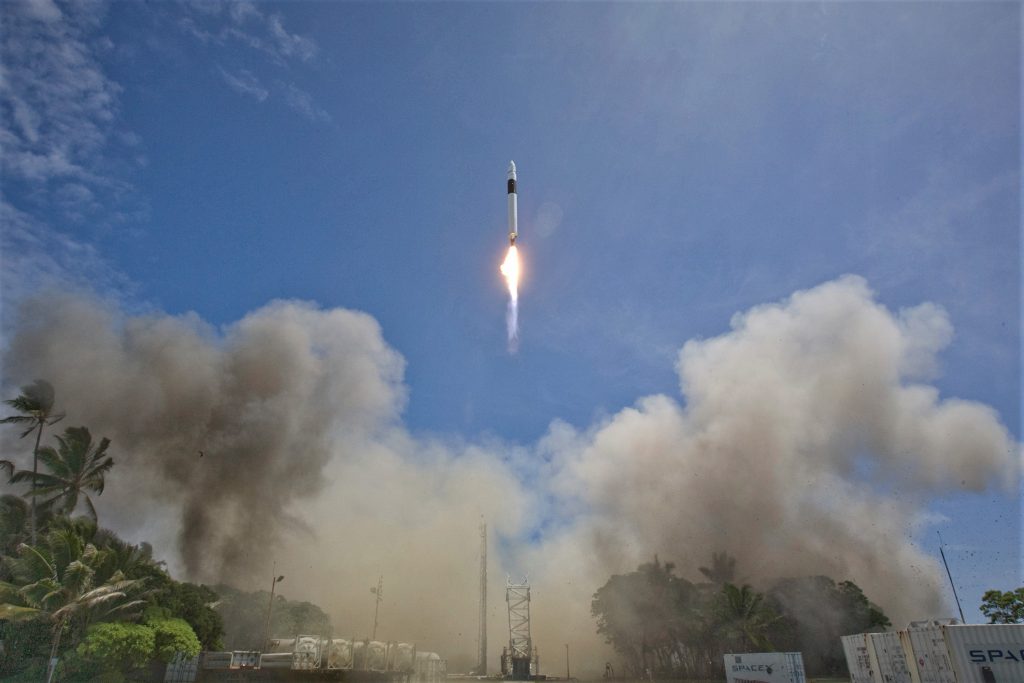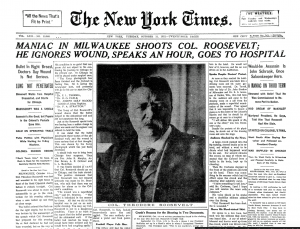Have you ever dreamed about traveling to space? Of course you have. It is usual for kids to imagine that you could travel to space. However, the older you get, the more aware you become of the difficult task that is traveling to space. Elon Musk, a multimillionaire businessman, technology entrepreneur, investor, and engineer, also had these childhood fantasies. Thus, when he had the opportunity and budget, he built his own company in order to accomplish these dreams. This is the story of a businessman who failed multiple times to achieve a childhood fantasy, and, along the way, made a big step for human history.

After being fired from PayPal, Musk revisited his childhood fantasies: rocketships and space travel. He went to a nonprofit group called Mars Society, and donated $100,000 to them to fund a Mars research station in the desert. At this time, Musk had malaria –an intermittent and remittent fever — so he wanted to accomplish something meaningful for the world: send 1 million people to Mars in a 10-year time frame.1 With this idea, he created an organization called the Life to Mars Foundation. This organization had the goal of sending a plant to Mars and growing it with Mars’ resources. However, this goal proved more difficult than originally thought. The price of a new rocket was too expensive for a limited budget. After Musk realized that it was impossible to buy a new rocket for this organization, he stopped this investment, deciding this organization was a waste of his money.2
Despite the failure of his first organization, Elon Musk didn’t give up on his goal of doing something meaningful for human beings. He researched Mars missions throughout history, and he realized that there had not been enough missions in order for human beings to be a multi-planet species. After he realized this, he created the first private space company in 2002, named SpaceX, with this same idea of colonizing Mars. The first goal of this company was to build a rocket with research and commercial functions that could be reused multiple times as if it were an airplane. Moreover, this rocket would modernize space businesses. This rocket’s price point would make it easier to access space. This rocket was called Falcon 1.3

Musk’s radical productivity has helped him succeed. He can work 16 hours a day, only resting 8 hours, which helped him create his first company called X.com, an online bank, which made him a millionaire. As hard as he works to achieve in his companies, he wants the rest of his team, the employees of SpaceX, to work as hard as he does. This was difficult to achieve because it has not been easy to find people as hard-working as himself. For that reason, he fired the “lazy people” of the company and replaced them with young engineers from recognized universities. With this idea, SpaceX was able to grow faster than before.4
To find these excellent engineers, Musk had to look for them all over the country. Thanks to his networks, it was easier to know where to start, though he still had to travel around the country to recruit them. One example is Jeremy Hollman, one of the young engineers who traveled to Texas to work on the rocket. Because of his young age, he didn’t have a lot of responsibilities, making it easier for him to move to Texas and commit his time to this project. 5
The construction of a rockets was not an easy task. Before the creation of SpaceX, government companies were the only ones who built rockets. Musk traveled to Russia to look for resources for his rocket; however, the price of these resources was too high. In order to continue with the construction of the rocket, Musk decided to construct its resources or reuse parts from other machines. For example, Jeremy Hollman, one of the young engineers of SpaceX, discovered that changing the seals, a method of containing fluid within a vessel of the rocket with the seals from a car was enough to use them in the rocket.6 Moreover, Musk, instead of using air force bases, that were expensive and had a long wait time, he used a former U.S. military missile test site on the Kwajalein Island (Kwaj) between Guam and Hawaii in the Marshall Islands, and adapted it to his needs.7 With more ideas like this, and with technology innovations, SpaceX was able to construct more modern rocket parts than even those NASA was building.
The distances between the launch system, the place for operating and monitoring the launch located in California, and the launch area were too far, which made Musk think about an efficient solution to this problem. At that moment, he had another company called Tesla Motors from which he was beginning to make a lot of money; as a result, he had a private jet to travel between his companies. Elon Musk started to use his own private jet to transport the employees from one city to the other in a shorter period of time. This helped in the productivity of the construction of the Falcon 1.8

After the construction of the $6.7 million 21-meter-tall Falcon 1, SpaceX prepared for the first launch of this grand rocket. The first launch attempt was on March 24, 2005; however, the launch was scrubbed. According to Chris Bergin, in his article for NASA Space Flight,
Moments after launching from its launch pad at the Kwajalein Atoll, the vehicle was seen spinning out of control, before communication and its downlink was lost. SpaceX have confirmed the rocket was destroyed.9
Despite the failure of the first launch attempt, Musk and his team started to fix the rocket’s problems and made a second launch on March 21, 2007, almost one year after the first launch attempt. The Falcon 1 flew for a couple of minutes without any problem; nonetheless, the rocket started to wiggle and then blew up.10
On August 2, 2008, the SpaceX engineers prepared the Falcon 1 for its third launch; however, it failed again. Elon Musk wrote an article for SpaceX News where he talked about this,
On August 2nd, Falcon 1 executed a picture perfect first stage flight, ultimately reaching an altitude of 217 km, but encountered a problem just after stage separation that prevented the second stage from reaching orbit.11

The SpaceX employees had worked under a lot of pressure for six weeks to make the fourth and possibly final launch of the rocket on September 28, 2008. In the afternoon that day, the SpaceX team raised the Falcon 1 into its launch position. The SpaceX employees were nervous; they had worked so hard on that rocket for six years. Around nine minutes into its journey, the Falcon 1 shut down just as planned and reached orbit. The Falcon 1 became the first privately developed liquid-fuel rocket to orbit the Earth.12 “When the launch was successful, everyone burst into tears,” Kimbal Musk, Elon Musk’s brother, said. “It was one of the most emotional experiences I’ve ever had.”13
With great success, Elon Musk made more goals for his company. He started to construct the Falcon 9, a bigger rocket with the capacity of taking people to Mars. Moreover, Musk and his team started to design the Dragon Capsule that would be used one day to take human supplies to the International Space Station. Both the Falcon 9 and Dragon Capsule had a cost of $1 billion to complete. However, with the commercial space travels that SpaceX started to do, the construction of these two rockets can be accomplished.14
Thanks to the success of the Falcon 1, we are closer to the possibility of colonizing Mars. Elon Musk plans to take thousands of people to Mars in his commercial rockets in order to create a society on Mars. This sounds like science fiction; however, with the effort of Musk, the colonization of Mars might just be the future of human beings.

- Mike Wall, “SpaceX’s Elon Musk Unveils Interplanetary Spaceship to Colonize Mar,” Space.com (2016), https://www.space.com/34210-elon-musk-unveils-spacex-mars-colony-ship.html. ↵
- Ashlee Vance, Elon Musk: Tesla, SpaceX, and the Quest for a Fantastic Future (New York: Ecco, 2015), 98-106. ↵
- Erik Seedhouse, SpaceX’s Dragon: America’s Next Generation Spacecraft (Chichester, UK: Springer, 2016), 5. ↵
- Ashlee Vance, Elon Musk: Tesla, SpaceX, and the Quest for a Fantastic Future (New York: Ecco, 2015), 122-123. ↵
- Ashlee Vance, Elon Musk: Tesla, SpaceX, and the Quest for a Fantastic Future (New York: Ecco, 2015), 122-123. ↵
- Ashlee Vance, Elon Musk: Tesla, SpaceX, and the Quest for a Fantastic Future (New York: Ecco, 2015), 123. ↵
- Steven Muegge and Ewan Reid, “Elon Musk and SpaceX: A Case Study of Entrepreneuring as Emancipation,” Technology Innovation Management Review 9 (2019): 18. ↵
- Ashlee Vance, Elon Musk: Tesla, SpaceX, and the Quest for a Fantastic Future (New York: Ecco, 2015), 128. ↵
- Chris Bergin “Falcon 1 suffers launch failure,” NASA Space Flight (2006), nasaspaceflight.com/2006/03/falcon-1-suffers-launch-failure/. ↵
- Ashlee Vance, Elon Musk: Tesla, SpaceX, and the Quest for a Fantastic Future (New York: Ecco, 2015), 142. ↵
- Elon Musk “Falcon 1, Flight 3 Mission Summary,” SpaceX News (2008), https://www.spacex.com/news/2013/02/11/falcon-1-flight-3-mission-summary. ↵
- Emily Shanklin “SpaceX Successfully Launches Falcon 1 To Orbit,” SpaceX News (2008), https://www.spacex.com/press/2012/12/19/spacex-successfully-launches-falcon-1-orbit ↵
- Kimbal Musk, interview by Ashlee Vance, in Elon Musk: Tesla, SpaceX, and the Quest for a Fantastic Future (New York: Ecco, 2015), 203. ↵
- Ashlee Vance, Elon Musk: Tesla, SpaceX, and the Quest for a Fantastic Future (New York: Ecco, 2015), 204. ↵



38 comments
Victoria Davis
I never had read this much information on Elon Musk before, but it gave a lot of great information and background knowledge how he and his team really became successful. It was interesting on how the money came to be, his team, and the how many trials and errors they had to go through to get it right. It was a well put together article with all the right information needed.
Kaleb Werku
Elon Musk is a man with insane work ethic and big dreams and when you have tht combination great things happen. Ofcourse, like every great mind he had to face multiple failures before they can succeed. Now thanks to his effort we are getting closer to hopefully one day living on mars that would be a historic achievment.
Stephanie Cerda
I haven’t heard much about Elon Musk’s space interesting apart from what I hear occasionally on the news, or if it’s trending. All I know about him, is about his cars; Teslas. I find it amazing how technology has become so advanced that the possibility of traveling to another planet, and even colonizing it, isn’t too far fetched. Technological advancements have really come far. It’s highly innovative. I don’t really like Elon Musk as a person very much, but I must admit his technology and inventions have impacted the modern world tremendously.
Addie Piatz
I’ve always loved space and all the research and discovery thats come with it. I think its so wonderful how he stayed so true to his dream and spent so much time doing what he loved. Mars has been a big topic of discussion, especially with all the global warming talk thats been going around, and how it could possible be the next place of life. The thought is truly scary to me to think about living there but the research is very interesting and i enjoyed reading this article very much.
Sabrina Doyon
I really admire Elon Musk’s determination in his goals. His ambition is inspiring and I love the work he put into this idea of sending people to Mars. It is fantastic to read about people pushing past failures and toward successes. I didn’t know the overall story of SpaceX and it is an interesting view of the man. I really enjoyed this article and it gave a great insight into Musk’s space dream.
Isabella Torres
The thought of colonizing Mars has always been really interesting to me. Elon Musk really persevered through the failures he experienced including investing money is Mars Society as well as the Falcon 1. I admire the fact that after these failures, he did not just stop there. It must have been horrible to see the Falcon 1, an incredibly large, expensive, and time consuming project, be destroyed upon takeoff. However, Musk truly has a passion for what he does and he has come to find great success through his determination and persistence.
Michael Lazcano
It’s so bizarre that in these modern times that we are working towards going to Mars and possibly colonizing it. Elon Musk is definitely one of the most innovative and visionary minds of our time, and his drive to explore more of our universe and also contributing to the whole humankind as well. His work in SpaceX and Tesla of course have been very successful but there are more advancements we must make to get to Mars and Elon is at the forefront.
Thalia Romo
Learning about Elon Musk’s passion for space flying is interesting. I find it charming how he invested so many years, alongside a whole crew, in order to perfect his dream. It takes a lot of courage and belief to continue when something doesn’t go good the first couple times. Elon’s dream of colonizing Mars is interesting to me because I don’t think of leaving Earth, nor do I just have money to invest in an experience like that. However, if an instance in which individuals are sent to Mars happen in the near future that will be exciting.
Felipe Macias
Elon Musk is the man who everyone has their eyes on an will continue to do so for decades to come. From Tesla to The Boring Company, Musk shapes the world how he deems it could be efficient and realistic. His innovation though, are outlandish and surreal, yet his comes with error and trials. He is always critiqued, though we must realize he is human and needs to requires a decent patience from the public.
Nelly Perez
I never knew much about Elon Musk. Teslas are what drew me to him at first, but now I got to learn more of him through this article. Elon Musk never forgot his space dream after growing up. He created the SpaceX organization and sought after the mission to bring people to Mars. He will be able to accomplish that mission in the years to follow.